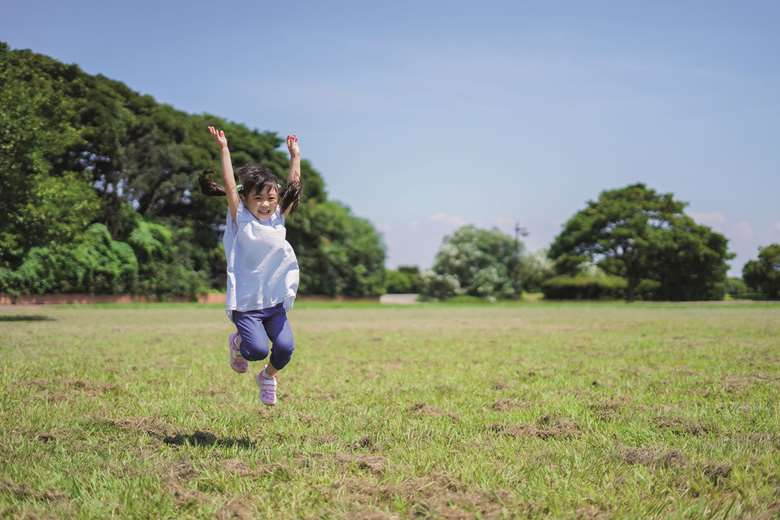EYFS activities - Birth to three… jumping
By Dr Lala Manners
Tuesday, June 1, 2021
The importance of jumping, and how it relates to the development of later skills such as strength and balance. By Dr Lala Manners

The sensation of moving up and down is a very common and early physical experience as babies are lifted in the air, or bounced on knees. This movement is usually rhythmical, joyful and energetic, informing the initial sensation of jumping long before the actual skill is acquired.
Interestingly, the preliminary stages of jumping and the form it often takes in the elderly look very similar, as children have yet to gain the strength and skill needed, and the elderly are losing both; but each age group can equally enjoy it. In early childhood, jumping is always a favourite activity and plays a vital role in developing later skills such as dance, gymnastics and many other sports.
In detail
Once children can pull themselves to standing, bobbing and bouncing become a vital part of their daily movement diet. As they become stronger – more balanced and co-ordinated – they will let go of any support and bounce up and down on the spot, often with legs wide and arms flapping in time to music. This stage may go on for a while and it is vital not to rush through it, or provide unnecessary ‘help’.
With increased confidence and competence, children will start to jump from one foot to the other – often with straight legs – looking down and holding their arms behind them. This is a very inefficient movement pattern, but again, it is an important part of the process in reaching a mature jumping form.
By around three years, most children can jump two-footed with the head held up, eyes forward, and arms beginning to help propulsion. Jumping forwards is easier than upwards, and they will begin to play around with speed and direction. As they mature, jumping remains a vital element in their play, although differences may be noted in choice of games and apparatus.
Importance
Jumping is a very effective way to promote overall body strength, co-ordination, balance and agility. It is a movement skill that may be practised by all age groups in some form and in many different environments. It is a skill that children enjoy improving over time as they can jump higher, further and create ever more challenging opportunities.
- Balance: jumping is a great way to stimulate the vestibular system that needs continual refreshing through movement to function optimally.
- Strength: as children emerge from the crawling stage, being upright presents a wider range of movement options. Jumping is a movement perfectly designed to promote lower body strength that impacts a child's confidence to explore and create further.
- Co-ordination: jumping is a very rhythmical movement, and as children become more energy-efficient, their jumping will be more precise and linked successfully to other skills, such as sitting down/standing still.
What to do
- Barefoot is always best whenever and wherever possible. Children need to strengthen the muscles around the ankle joint, and the arches of the feet. Also a more realistic sense of balance is experienced without footwear.
- Appreciate that early bouncing and bobbing are a very important part of the jumping process and should not be rushed.
- Try not to interfere – let children rehearse and refine their own jumping form in whatever way suits them. This will vary widely.
- Outside: encourage jumping in puddles, mud, sand, leaves; jump down from a small ledge, across a narrow gap, over a tree trunk, between paving stones and into adult arms from a height.
- Inside: offer jumping possibilities on cushions, air mattresses, bubble wrap, holding hands with adults, standing on a squishy ball and by climbing up and jumping down safely.
Taking it forward
As children grow and develop, they will create their own opportunities to make jumping more challenging – and riskier. They are usually good at gauging their own level of competence and become interested in the form of the movement, e.g. how to land properly.
- Include music, so they learn to keep a steady beat. You can clap.
- Play simple games, e.g. musical bumps/statues (ignore the ‘leaving out’/winning element).
- Introduce apparatus, e.g. jump over or onto a moving rope.
Benefits for all
- The sensation of jumping can lift mood – help breathing and raise heart rate.
- Place hands flat on a table while standing. Lift and lower both heels, take weight on your hands and bounce vigorously. Lift feet if you are feeling confident.
- Hands on the table, jump feet out and in, or back and forwards.
- Hop from one foot to the other.
- Be as energetic as possible.
ABOUT THIS SERIES
This is the fifth in a series on essential physical skills and how to support them in children from birth to three. Dr Lala Manners is a physical development trainer and director of Active Matters
Download Now








